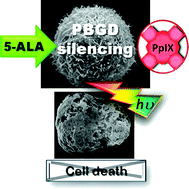 A team from Bar-Ilan University, Israel, have revealed the importance of porphobilinogen deaminase (PBGD) expression levels on the efficacy of 5-aminolevulinic acid-based photodynamic therapy (ALA-PDT)
A team from Bar-Ilan University, Israel, have revealed the importance of porphobilinogen deaminase (PBGD) expression levels on the efficacy of 5-aminolevulinic acid-based photodynamic therapy (ALA-PDT)
ALA-PDT is a method used worldwide for the treatment of various malignancies. It utilises the heme synthesis pathway to accelerate the synthesis of heme precursors, porphyrins. Light irradiation of the tumour excites the prophyrin molecules and induces the formation of reactive oxygen species resulting in cell death. The mechanisms of porphyrin synthesis regulation are not fully understood, but this study provides a big advance.
The team investigated the effect of expression levels of two main enzymes in heme biosynthesis, ALA dehydratase (ALAD) and PBGD on the capacity of K562 cells to undergo cell death following ALA-PDT. They discovered a novel regulation feedback of PBGD on ALAD activity which is fundamental for the regulation of the heme synthesis pathway.
Interested in knowing more? Read the full article for free until 13th July.
The centrality of PBGD expression levels on ALA-PDT efficacy
Avital Schauder, Tamar Feuerstein and Zvi Malik
Photochem. Photobiol. Sci., 2011, Advance Article
DOI: 10.1039/C1PP05085K, Paper










